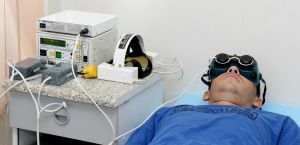 Depersonalization is a disorder in which a person distortively perceives his own "I", alienated from his personality, body.
Depersonalization is a disorder in which a person distortively perceives his own "I", alienated from his personality, body.
The individual perceives himself as an observer of his own body, and perceives his voice, thoughts and actions as the actions of another person. At the same time, a person retains a sense of reality and can give an objective assessment of the environment.
Depersonalization is not considered a mental disorder. An attack of this syndrome occurred at least once in 70% of the population.
The most common depersonalization disorder is observed in childhood during the formation of self-awareness. This is expressed in the perception of occurring events as unreal, a feeling of non-belonging to oneself. Episodically occurring seizures are not pathological. The diagnosis is made when the seizures are persistent and last for a long time.
Contents
- History of the discovery of the diagnosis
- Species of the manifestation of the
- syndrome Factors that provoke the "blurring of the personality"
- Clinical picture and symptoms
- Diagnosis
- Features of the
- flow How to overcome the feeling of unreality and loss of self
History of the discovery of the diagnosis
The depersonalization syndrome was first described in publicationsFrench psychiatrist Jean Eskirol in 1838, as well as in the works of Jacques de Tours in 1840.They drew attention to the symptoms that existed in some patients, which were expressed in the feeling of alienation of one's own personality and body.
The first work devoted entirely to this syndrome was published by Krishaber, and contained 38 clinical observations.
The term "depersonalization" as a designation for the loss of one's self, separation from one's personality, was proposed in 1898 by Louis Doug, a French philosopher and philologist. Later, Doug published a paper in which he summarized the experience of studying the syndrome that has accumulated over the years.
Among the author's native depersonalization syndrome in his works described V.Yu. Vorobiev, A.B.Smulevich, A.A.Magbaryan, Yu. L.Nuller.

Species of the
syndrome Under depersonalization, several types of disorder are understood, for each of them the feeling of unreality is expressed in different ways:
- Somatopsychic depersonalization( disorganization of the body scheme).The individual feels changes in his body, ceases to perceive real dimensions, the shape of parts of the body or body as a whole. The patient can perceive the body or body parts as swollen, heavy, excessively large, or small, to feel excess parts of the body. At the same time he understands the unreality of these sensations.
- Autopsychic depersonalization( loss of personality).The individual has a sense of change in himself, loss of personality, loss of emotion, his own opinion. This causes the experience of the patient. Own feelings are felt as belonging to another, the individual observes his psycho-emotional processes, like an outsider from the side. Man believes that he has no control over his feelings, will, thinking. At the same time, he notes that he feels emptiness inside, does not have any mood, events have no influence and reflection on his inner world.

- Allopsychic depersonalization( derealization).The individual is distorted by the sense of the world around him. The real world is perceived as fantastic, alien. All events seem unreal, staged, theatrical production. The world is perceived similar to a computer game, a fantastic film. The environment can be perceived as inverted 180 degrees, or reflected in the mirror.
- Anesthetic depersonalization. It is expressed in the distorted perception of painful sensations in the presence of long painful conditions. There is a decreased response to pain.
Factors that provoke "blurring of personality"
Depersonalization may indicate that the patient has such psychiatric disorders as schizophrenia, schizotypic disorder, bipolar disorder, panic disorder, depression.
If there is no mental disorder in the patient's history, then it can be said that almost always depersonalization is a protective reaction of the human psyche to stresses, emotional shocks. Among the causes of the syndrome are also called:
- Biochemical and neurological disorders .The development of the disorder results in the presence of oxidative stress, modification of receptor proteins, disorders in cortisol production, disorders in the interaction of neurotransmitters, in the opiate system, and a decreased function of gamma-aminobutyric acid. Studies have shown that when attacks of the syndrome there is activity in various parts of the brain, which is absent in healthy people.
- Somatic, Mental and Neurological Diseases .To the development of the syndrome can lead manic-depressive states, anxiety, phobic disorders, psychosensory disorders, schizophrenic disorders, psychotic forms of affective disorders, organic diseases of the nervous system, congenital defects of the nervous system, endocrine pathologies, brain tumors, epilepsy.

- Narcotic drugs and addictions .The use of Ketamine, Dextromethorphan, Fenclidine( NMDA receptor blockers) can lead to the development of depersonalization. To this also lead to substance abuse, alcoholism, smoking marijuana.
- Injuries to .The syndrome can develop due to craniocerebral trauma, intracerebral hemorrhage.
- Internal conflicts .The situation when a person does not have a moral core, certain life goals, an integral worldview, an internal conflict between different sides of the personality can lead to the emergence of the syndrome.
- Stress and psycho-traumatic situations .During stress, a large number of endorphins are produced, feedback mechanisms( necessary for neurochemical homeostasis) are broken, and as a result, the pleasure center and the limbic system can be blocked. As a result, the limbic system responsible for emotions loses its ability to respond to constant and chaotic stimulation, and ceases to respond. This leads to the development of the syndrome. The intensity of stress and the depth of the trauma do not matter, the important thing is how the individual perceives the event. This can be both sudden and long-lasting events.
Clinical picture and symptoms
Depersonalization can develop either gradually or suddenly, the symptoms and frequency of their manifestation vary from patient to patient. Among the signs of the disorder, you can call:
- a sense of unreality in the world;

- confusion, misunderstanding of what is happening;
- perception of their body parts as strangers;
- feeling of own insignificance, helplessness, isolation, abandonment;
- decrease in intellectual abilities, spiritual level, emotional sphere;
- loss of views on life, foundations and beliefs;
- distorted perception of the body, denial of the existence of parts of the body;
- lack of pleasure from food, satiety;
- increased anxiety;
- inability to adequately assess time and space;
- perception and vision of oneself as an outsider;
- sensation of the second "I", a split personality;
Diagnosis of
Patients with complaints of depersonalization should be carefully examined. It should be determined whether it is a symptom of psychiatric illness, or is of a neurological nature. This syndrome can be the result of serious impairment of brain function, brain tumor, epilepsy.
Depersonalization is diagnosed if:
- the patient complains about the distorted perception of his body and its parts , the duality of consciousness, the belonging of his feelings and emotions to another's body;
- the individual retains the critical thinking of , the patient realizes the painfulness of his manifestations, realizes that all distortions of reality are visible only to him;
- the patient retains the clear consciousness of ;
- and , the patient complains about the sensation of the unreality of the world, the distortion of objects, the fact that the surrounding reality does not recognize.
There is a reliable method for defining and distinguishing anxiety, depression and depersonalization - the diazepam test, proposed by the Russian professor Yu. L.Nuller. The patient is given a solution of Diazepam( the usual dose is 30 mg, elderly and weakened patients 20 mg).There are three expected reactions:
- Depressive - the symptoms do not change, the patient experiences drowsiness, falls asleep.
- Alarming - affective symptoms disappear quickly, a feeling of euphoria sets in.
- Depersonalization - a positive reaction occurs after 20 minutes, the disorder is partially or completely reduced.
Features of the
 course Symptoms of depersonalization develop suddenly in most patients. Most of the patients belong to the age group from 15 to 30 years. Sometimes the disease occurs in children under 10 years of age, is less likely to occur after the age of 30, and is almost not observed in older people.
course Symptoms of depersonalization develop suddenly in most patients. Most of the patients belong to the age group from 15 to 30 years. Sometimes the disease occurs in children under 10 years of age, is less likely to occur after the age of 30, and is almost not observed in older people.
The attack can last from several minutes to several years. At the onset of the development of the disease, all symptoms may temporarily disappear.
Personality depersonalization practically can not be treated with tranquilizers, antidepressants, neuroleptics. Resistance can be reduced with plasmapheresis. The syndrome often acts as a protective mechanism of the body, and contributes to an increase in the overall level of immunity.
If the syndrome develops against a background of a schizotypic or depressive disorder, then it refers to "negative symptoms".This means that there is resistance to treatment. In this case, drugs with anti-negative action( Amisulpride, Quetiapine, SSRI Escitalopram) are prescribed.
Depersonalization can be caused by taking psychotropic drugs. The erroneous diagnosis of depressive and anxiety disorders, as well as the erroneous administration of drugs, leads to the development of the disorder.
These drugs include neuroleptics and antidepressants of the SSRIs. It is also possible to develop the syndrome with insufficient treatment of anxiety disorders, with the appointment of too powerful antidepressants, with increased anxiety and depression at the beginning of the course of antidepressant therapy.
Remission can occur within a few months, and suddenly. Therefore, it is necessary to carefully monitor the patient's condition to prevent drug poisoning due to the disappearance of resistance.
How to overcome the feeling of unreality and loss of self
Before the appointment of therapy, it is necessary to conduct research and establish the factors that caused the development of this syndrome. Treatment of depersonalization should be aimed at eliminating the main cause of depersonalization: diseases of organic origin, mental illness, neurological pathology. If the patient does not have other medical history, then the therapy is aimed at depersonalization, as a separate pathological condition. 
Regardless of the form of depersonalization, therapeutic interventions should begin with an explanatory conversation in which the doctor explains the nature of the disease, and methods of dealing with it, informs about the non-pathological nature of this condition.
If depersonalization is an independent disease, then the main treatment is in the psychotherapeutic methods. The task of psychotherapy is to shift the individual's attention from inner experiences and sensations to the external world. The patient needs to be taught how to interact with the surrounding world, the society. Hypnosis and auto-training are considered effective methods.
A motivational technique of suggestion is also used, in which the patient is explained that he is able to switch his attention to the surrounding world during the occurrence of seizures. Such suggestion helps to reduce the intensity of the manifestation of the syndrome. A similar mechanism of work has also sessions of auto-training. Regular sessions of therapy are aimed at improving the patient's social activity, eliminating violations, and also for social rehabilitation.
With mild conditions, specialists prescribe the intake of vitamins, antioxidants, nootropics, and psychostimulating drugs.
In the case of more severe forms of the syndrome, electroconvulsive, atropine-comatose therapy is used.
Patients with anxiety attacks, panic attacks are prescribed tranquilizers, neuroleptics, antidepressants. With concomitant disorders in the work of the opioid system of the brain, antagonists of opioid receptors, serotonin inhibitors and anticonvulsants are used.
Antidepressants with sedative effect, antipsychotics, nootropics, cytoprotectors can be used in the therapy of depersonalization.
 As an auxiliary treatment can be appointed: taking antidepressants, a course of massage, herbal medicine, physiotherapy, acupuncture.
As an auxiliary treatment can be appointed: taking antidepressants, a course of massage, herbal medicine, physiotherapy, acupuncture.
The effectiveness of treatment increases with the use of positive emotions. Improvement of the patient's condition, which comes in the process of treatment, is an emotional stimulus for the patient.
Achieved success in treatment, achievement of a patient in the social sphere increase the patient's desire to continue treatment. Patients with severe forms of depersonalization have a negative or passive attitude toward therapy.
As prevention methods, it is recommended to avoid stressful situations and overcome them, adhere to a healthy lifestyle, lead an active lifestyle, play sports, adhere to the regime of the day, have a healthy sleep.
Following these recommendations helps maintain mental balance, helps to cope with stress, and also prevents the appearance of signs of the syndrome.



